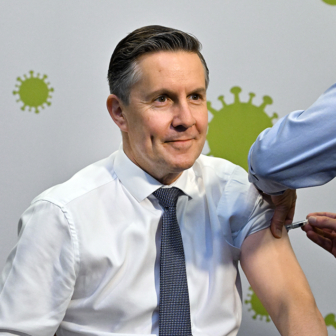Mental health “must be front and centre of every country’s response to and recovery from the COVID-19 pandemic,” says a 13 May report from the World Health Organization. In Australia, mental health advocates have warned that mental health problems will be the “second wave” of the pandemic, with a “much deeper and longer trough.”
Australia’s mental healthcare system has long been fragmented and under-resourced. Despite increasing rates of mental illness, and despite the impact on individuals, families and society, services fall well short of demand. The coronavirus made the problem worse, and has highlighted how much needs to be done to provide adequate care.
To their credit, Australian governments have recognised the need to act. But so far they haven’t done enough. A bigger investment is needed to ensure that Australians in distress — whether they’ve had direct exposure as patients or healthcare staff, are elderly, disabled or isolated, or are suffering from joblessness or anxiety — get help in a timely fashion, and to prevent suicides from outstripping the coronavirus’s toll to date. Given that the economic adversity may have yet to peak, the damage to mental health and wellbeing could well intensify.
Studies of the impact of other pandemics — SARS, Middle East respiratory syndrome, influenza and Ebola — have shown how these engender fear, anxiety, emotional distress, and post-traumatic stress symptoms. Other studies have shown how global economic crises can affect mental health and lead to an increase in suicides.
Recent Australian surveys highlight the nature and extent of the mental health problems caused by the coronavirus pandemic and the economic downturn. Significant numbers of respondents to a survey in April by YouGov feared they would be unable to pay their bills (60 per cent), they would lose their job (49 per cent), they would not be able to feed their family (48 per cent) or they might lose their home (38 per cent). Home schooling and caring for children in isolation for longer periods is adding to the stress. The survey found a large increase in the number of Australians drinking alone, and one in four relationships under strain.
Researchers at the Australian National University came up with similar findings. But while two-thirds of respondents reported feeling anxious or worried, the survey also picked up an increase in social trust and cohesion.
A study by UNICEF Australia looked specifically at how the coronavirus pandemic and the associated lockdown is affecting teenagers. Almost half of young people surveyed reported an increase in stress and anxiety, with higher rates for girls than boys. Much of this is attributable to the uprooting of their lives, with nearly nine out of ten having had to stop seeing their friends and most having had their education and extracurricular activities disrupted or stopped entirely.
In the weeks since these surveys were conducted conditions have almost certainly worsened, especially for adults, as the economic impacts of the coronavirus shutdown become more apparent.
Mental stress, which ranges in intensity from mild anxiety to severe post-traumatic stress disorder, disrupts normal brain function and causes impairments in learning and memory. Chronic stress influences the onset and severity of depression and cognitive decline, and it affects the body even at the genetic level. The physiological consequences of stress depend on the intensity and duration of the stress factors, and different people will perceive and react to these differently depending on their resilience. These differences help explain why some people are struggling while others are finding they are productive and content during this period of social isolation.
The increase in mental stress is reflected in requests for help. Lifeline, for example, was hit by a 25 per cent increase in calls in March, bringing the national total to around 90,000 calls, the highest in the organisation’s fifty-six-year history. Google reported a 75 per cent increase in searches for advice on domestic violence, and Beyond Blue has seen a 60 per cent increase in contacts compared with this time last year.
Healthcare workers on the front line of the pandemic are probably under the greatest stress of all. Doctors, nurses and emergency workers already have high rates of burnout, and doctors in particular have high rates of suicide and depression. With these health professionals providing care to very ill patients and also worrying about their own safety and that of their families, Covid-19 has created new pressures.
Alerted to these increasing mental health needs, the Australian government allocated $74 million (over two years) for mental health services in the $1.1 billion package of coronavirus health funding introduced on 28 March. This included $14 million to existing help services, including Lifeline and Kids Helpline, $10 million to Beyond Blue for a dedicated coronavirus wellbeing helpline (with Medibank Private providing a further $5 million), and funds for a range of support services and communication campaigns covering frontline health workers, people receiving aged care support, young people, Indigenous Australians, pregnant women and new parents.
Another $150 million was allocated for counselling services for families caught up in, or at risk of, domestic violence. Medicare subsidies for telehealth services were expanded significantly to allow GPs, psychiatrists, psychologists and other eligible health professionals to consult with patients using telephone and video conferencing.
Despite their obvious advantages in medically underserved areas, telehealth services had not previously been widely deployed or accessed in Australia. Of the 2.4 million visits to psychiatrists in 2018–19, only 66,000 involved telehealth. Doctors and patients have responded very positively to the new arrangements. They will continue until 30 September, when a review will determine whether conditions warrant an extension. The government will be under pressure to maintain the telehealth option as part of needed mental health reforms.
Several recent studies have provided additional information about the long-term mental health impact of the coronavirus and the isolation measures. Orygen modelling commissioned by the Victorian government shows that, without action, an extra 370,000 people in the state will seek mental health treatment or be hospitalised over the next three years as a result of the pandemic, with young people disproportionately affected, and hundreds more suicides will occur.
Work by the Brain and Mind Institute, or BMI, at the University of Sydney indicates a suicide surge that could take many more lives than Covid-19. Annual suicide rates could rise dramatically — from 3000 to as many as 4500 over each of the next five years, assuming unemployment rates go as high as 15 per cent. Youth suicides will make up almost half of the projected increase. Hospitalisations and emergency department visits for self-harm could rise by as much as 20 per cent.
Unchecked, this would mean a generational mental health crisis in some hard-hit regions, including those affected by the collapse of tourism. Over the next five years in one such area on the NSW north coast, an estimated half a billion dollars could be lost because of a fall in productivity directly attributable to coronavirus-generated increases in mental health disorders and suicide.
To prevent this disastrous outcome, the BMI team propose an increase in specialised mental health services, to be provided by mental health GPs, psychiatrists, allied health services and community mental health services, along with technology-enabled coordinated care and outreach and enhanced contact with and support for survivors of suicide attempts. Implemented nationwide, these services would mean an estimated 2650 fewer deaths, 33,450 fewer suicide attempts and 225,800 fewer presentations to emergency departments over the next five years.
Orygen’s Patrick McGorry, the BMI’s Ian Hickie and the Australian Medical Association’s Tony Bartone sent this research to the national cabinet with a letter calling for action. “The duration and depth of the disruption to our lives [from the pandemic] is not yet known,” they wrote. “However, we do know that people living in outer urban areas, rural and regional Australians, casual workers, those recently unemployed, and older workers will most likely be affected by the social and economic impacts. We must act quickly to increase key capabilities before the surge in demand for mental health services becomes evident.”
The national cabinet and the federal government responded on 15 May with $48 million for a National Mental Health and Wellbeing Pandemic Response Plan. Of this, $2.6 million will go to the National Suicide and Self-harm Monitoring System, which was announced in the 2019–20 federal budget at a cost of $15 million over three years. Sharing a further $4.7 million will be the National Suicide Prevention Research Fund, administered by Suicide Prevention Australia, and the National Suicide Prevention Taskforce.
For outreach, $19 million will go to Primary Health Networks to deliver readily accessible services by mental health nurses, and $3.5 million to Carers Australia and Carers Gateway to provide targeted assistance and information. Another $3.5 million was allocated for health information in languages other than English, and $3.5 million for Primary Health Networks to work with Indigenous Australians. Just $10.4 million was allocated for a national mental health communication campaign, which suggests that communication is not a key priority.
For Ian Hickie, these measures don’t “seem to reach the scale or the immediacy really required now to be ready for the really significant mental health problems that we will face over the next two years.” According to Patrick McGorry, “This is a very big wall we’re trying to build and we saw a couple of bricks put in the wall [on 15 May], but when is the rest of the wall going to be built?”
The government’s plan says little about integrating mental health and substance abuse services, and provides no funding for the latter, despite polls showing that 20 per cent of Australians say they are purchasing more alcohol and 70 per cent of that group report they are consuming more alcohol than previously. The already overburdened rehabilitation system is being pushed to breaking point.
The government has also appointed its first deputy chief medical officer for mental health, Ruth Vine, to steer the federal response to the mental health implications of the coronavirus crisis. It is not clear how she will interact with the chief executive of the National Mental Health Commission, Christine Morgan. Chief medical officer Brendan Murphy told a parliamentary committee that Dr Vine would bring a clinical perspective to the work of the commission.
What else is needed to build a twenty-first-century mental health system out of a fragmented set of services that already needed a lot of work, especially in the wake of the bushfires?
Leaving aside for a moment major structural changes of the kind discussed by Jennifer Doggett in Inside Story last year, five early actions are essential. First, telehealth can only deliver its promised benefits if everyone has access, and that means tackling the digital divide and the exigencies of the National Broadband Network.
Second, all frontline healthcare workers should be offered counselling now to forestall long-term symptoms of overwork and trauma, and to ensure they can keep doing their jobs with the intensity demanded of them — something that will be even more essential if there is a resurgence of Covid-19.
Third, given the strong links between unemployment, income inequality and suicide, priority needs to be given to providing a combination of education, employment, social and health services, especially for young people. This will require greater coordination between sectors and jurisdictions, and more attention to the already-evident gaps in safety nets. Yes, this will be yet another cost to the budget, but without it the cost will be measured in lives lost.
Fourth, more must be done to tackle what the BMI’s Sebastian Rosenberg calls the missing middle — the big service gaps for the people most in need of care. That means more specialised outpatient care and multidisciplinary care for those in need.
Finally, none of this can be done without efforts to address the missing mental health workforce. Australia needs more GPs trained to better integrate mental and physical healthcare, more psychiatrists and psychologists working in the public sector and outside the major cities, more mental health nurses and more peer-support workers.
The existing gaps in the system will come under intense scrutiny in the final report of the Productivity Commission’s mental health inquiry, which goes to government next month and must then be released within twenty-five sitting days. Last October’s draft report highlighted a lack of sustained investment in mental health treatment, poor coordination and a fundamental lack of responsiveness to the needs of those most affected. It also called for more prevention and early intervention measures, particularly for children and young adults.
The findings and recommendations from this final report, along with those from the royal commission into Victoria’s mental health system, due shortly, must drive the reforms needed to ensure that Australia’s mental health system cares properly for all who need treatment. •




